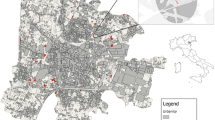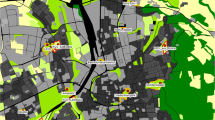Abstract
Biodiversity conservation and restoration in cities is a global challenge for the 21st century. Unlike other common ecosystems, urban landscapes are predominantly covered by gray, artificial structures (e.g., buildings and roads), and remaining green spaces are scarce. Therefore, to conserve biodiversity in urban areas, understanding the potential conservation value of artificial structures is vital. Here, we examined factors influencing the distribution of ferns in building gaps, one of the more common artificial structures, in urban Sapporo, northern Japan. We observed 29 fern species, which corresponds to 30 % of all fern species previously recorded in Sapporo. The four dominant species were Equisetum arvense, Matteuccia struthiopteris, Dryopteris crassirhizoma, and Athyrium yokoscense. Statistical analyses showed that their distribution patterns in building gaps were associated with both local- and landscape-scale environmental factors. Although ground cover type and distance from continuous forests were the most important determinants, other factors such as the amount of solar radiation, habitat age (years after building development), and urban district type also affected fern distribution. These results suggest that building gaps act as an important habitat for ferns in highly urbanized landscapes. Policy makers and city planners should therefore not overlook these cryptic habitats. Clarifying the ecological functions of artificial structures will both further our understanding of novel ecosystems and develop a new framework for conserving and restoring biodiversity in human-modified landscapes.




Similar content being viewed by others
References
Alvey AA (2006) Promoting and preserving biodiversity in the urban forest. Urban For Urban Green 5:195–201
Andersson TN, Lundegårdh B (1999) Growth of field horsetail (Equisetum arvense) under low light and low nitrogen conditions. Weed Sci 47:41–46
Asano S, Kuwabara Y (1990) The ecological encyclopedia of wild plants in Japan. Pteridophytes, Gymnosperms, and Angiosperms (Coripetalae). Zenkoku Noson Kyoiku Kyokai, Japan, in Japanese
Barrington DS (1993) Ecological and historical factors in fern biogeography. J Biogeogr 20:275–279
Bengston DN, Fletcher JO, Nelson KC (2004) Public policies for managing urban growth and protecting open space: policy instruments and lessons learned in the United States. Landsc Urban Plan 69:271–286
Blair RB (1996) Land use and avian species diversity along an urban gradient. Ecol Appl 6:506–519
Dearborn DC, Kark S (2010) Motivations for conserving urban biodiversity. Conserv Biol 24:432–440
DeCandido R, Allen D (2006) Nocturnal hunting by peregrine falcons at the empire state building, New York City. Wilson J Ornithol 118:53–58
Faeth SH, Bang C, Saari S (2011) Urban biodiversity: patterns and mechanisms. Ann NY Acad Sci 1223:69–81
Faria D, Paciencia MLB, Dixo M, Laps RR, Baumgarten J (2007) Ferns, frogs, lizards, birds and bats in forest fragments and shade cacao plantations in two contrasting landscapes in the Atlantic forest, Brazil. Biodivers Conserv 16:2335–2357
Foley JA, DeFries R, Asner GP, Barford C, Bonan G, Carpenter SR, Chapin FS, Coe MT, Daily GC, Gibbs HK, Helkowski JH, Holloway T, Howard EA, Kucharik CJ, Monfreda C, Patz JA, Prentice IC, Ramankutty N, Snyder PK (2005) Global consequences of land use. Science 309:570–574
Francis RA, Lorimer J (2011) Urban reconciliation ecology: the potential of living roofs and walls. J Environ Manag 92:1429–1437
Fuller RA, Irvine KN, Devine-Wright P, Warren PH, Gaston KJ (2007) Psychological benefits of greenspace increase with biodiversity. Biol Lett 3:390–394
Fuller RA, Gaston KJ (2009) The scaling of green space coverage in European cities. Biol Lett 5:352–355
Fuyuki A, Yamaura Y, Nakajima Y, Ishiyama N, Akasaka T, Nakamura F (2014) Pond area and distance from continuous forests affect amphibian egg distributions in urban green spaces: a case study in Sapporo, Japan. Urban For Urban Green 13:397–402
Gaston KJ (2010) Urban ecology. Cambridge University Press
Geographical Survey Institute (2011) Basic map information. Bigger than 1/2,500 scale maps. The outer peripheral lines constituting all buildings in Japanese
Greenery Promotion Department, Environmental Bureau, Sapporo (2011) Basic plan of green in Sapporo. Greenery Promotion Department, Environmental Bureau, Sapporo
Goddard MA, Dougill AJ, Benton TG (2010) Scaling up from gardens: biodiversity conservation in urban environments. Trends Ecol Evol 25:90–98
Grimm NB, Faeth SH, Golubiewski NE, Redman CL, Wu J, Bai X, Briggs JM (2008) Global change and the ecology of cities. Science 319:756–760
Hahs AK, McDonnell MJ, McCarthy MA, Vesk PA, Corlett RT, Norton BA, Clemants SE, Duncan RP, Thompson K, Schwartz MW, Williams NS (2009) A global synthesis of plant extinction rates in urban areas. Ecol Lett 12:1165–1173
Hara M (1992) Flora of Sapporo. Hokkaido University Press, Sapporo, in Japanese
Hobbs RJ, Arico S, Aronson J, Baron JS, Bridgewater P, Cramer VA, Epstein PR, Ewel JJ, Klink CA, Lugo AE, Norton D, Ojima D, Richardson DM, Samderson EW, Valladares F, Vila M, Zamora R, Zobel M (2006) Novel ecosystems: theoretical and management aspects of the new ecological world order. Glob Ecol Biogeogr 15:1–7
Ikin K, Beaty RM, Lindenmayer DB, Knight E, Fischer J, Manning AD (2013) Pocket parks in a compact city: how do birds respond to increasing residential density? Landsc Ecol 28:45–56
Imhoff ML, Bounoua L, DeFries R, Lawrence WT, Stutzer D, Tucker CJ, Ricketts T (2004) The consequences of urban land transformation on net primary productivity in the United States. Remote Sens Environ 89:434–443
Irvine KN, Warber SL, Devine-Wright P, Gaston KJ (2013) Understanding urban green space as a health resource: a qualitative comparison of visit motivation and derived effects among park users in Sheffield, UK. Int J Environ Res Public Health 10:417–442
Iwatsuki K (ed) (1999) Ferns and fern allies of Japan. Heibonsha Ltd. Publishers, Tokyo, in Japanese
Kowarik I (2011) Novel urban ecosystems, biodiversity, and conservation. Environ Pollut 159:1974–1983
Kurata S, Nakaike T (1997) Illustrations of pteridophytes of Japan. Vol. 1–8. Univ. of Tokyo Press, Tokyo, in Japanese
McCullagh P, Nelder JA (1989) Generalized linear models, 2nd edn. CRC press, New York
McKinney ML (2002) Urbanization, Biodiversity, and Conservation the impacts of urbanization on native species are poorly studied, but educating a highly urbanized human population about these impacts can greatly improve species conservation in all ecosystems. Bioscience 52:883–890
Miller JR (2005) Biodiversity conservation and the extinction of experience. Trends Ecol Evol 20:430–434
Moonen P, Defraeye T, Dorer V, Blocken B, Carmeliet J (2012) Urban physics: effect of the micro-climate on comfort, health and energy demand. Front Archit Res 1:197–228
Murakami K, Matsui R, Morimoto Y (2007) Northward invasion and range expansion of the invasive fern Thelypteris dentata (Forssk.) St. John into the Urban Matrix of Three Prefectures in Kinki District, Japan. Am Fern J 97:186–198
Murakami K, Morimoto Y (2008) Range expansion of two tropical to subtropical ferns, Ladder Brake (Pteris vittata L.) and lace fern (Microlepia strigosa (Thunb. ex Murray) K. Presl.), in the Urban Osaka Bay Area, Western Japan. Am Fern J 98:171–176
Naidoo R, Balmford A, Ferraro PJ, Polasky S, Ricketts TH, Rouget M (2006) Integrating economic costs into conservation planning. Trends Ecol Evol 21:681–687
Natuhara Y, Imai C (1999) Prediction of species richness of breeding birds by landscape-level factors of urban woods in Osaka Prefecture, Japan. Biodivers Conserv 8:239–253
Norton DA (2000) Conservation biology and private land: shifting the focus. Conserv Biol 14:1221–1223
Pharo EJ, Beattie AJ, Binns D (1999) Vascular plant diversity as a surrogate for bryophyte and lichen diversity. Conserv Biol 13:282–292
Pinheiro J, Bates D, DebRoy S, Sarkar D (2007) Linear and nonlinear mixed effects models. R package version 3:57
Ramalho CE, Hobbs RJ (2012) Time for a change: dynamic urban ecology. Trends Ecol Evol 27:179–188
R Core Team (2013) R: A language and environment for statistical computing. R Foundation for Statistical Computing, Vienna, URL http://www.R-project.org/
Richard M, Bernhardt T, Bell G (2000) Environmental heterogeneity and the spatial structure of fern species diversity in one hectare of old-growth forest. Ecography 23:231–245
Rosenzweig ML (2001) Loss of speciation rate will impoverish future diversity. Proc Natl Acad Sci U S A 98:5404–5410
Sakai AK, Allendorf FW, Holt JS, Lodge DM, Molofsky J, With KM, Baughman S, Cabin RJ, Cohen JE, Ellstrand NC, McCauley DE, O’Neil P, Parker IM, Thompson JN, Weller SG (2001) The population biology of invasive species. Ann Rev Ecol Syst 32:305–332
Seto KC, Güneralp B, Hutyra LR (2012) Global forecasts of urban expansion to 2030 and direct impacts on biodiversity and carbon pools. Proc Natl Acad Sci U S A 109:16083–16088
Soga M, Koike S (2013) Patch isolation only matters for specialist butterflies but patch area affects both specialist and generalist species. J For Res 18:270–278
Soga M, Yamaura Y, Koike S (2013) From ecological pessimism to conservation chance: reviving living dead in changing landscapes. Anim Conserv 16:16–18
Soga M, Yamaura Y, Koike S, Gaston KJ (2014) Woodland remnants as an urban wildlife refuge: a cross-taxonomic assessment. Biodivers Conserv 23:649–659
Soga M, Yamaura Y, Aikoh T, Shoji Y, Kubo T, Gaston KJ (2015) Reducing the extinction of experience: association between urban form and recreational use of public greenspace. Landsc Urban Plan 143:69–75
Stagoll K, Manning AD, Knight E, Fischer J, Lindenmayer DB (2010) Using bird–habitat relationships to inform urban planning. Landsc Urban Plan 98:13–25
The Building Center of Japan (2013) The building standard law of Japan
Williams ED (1979) Studies on the depth distribution and on the germination and growth of Equisetum arvense L. (field horsetail) from tubers. Weed Res 19:25–32
Yamaura Y, Amano T, Kusumoto Y, Nagata H, Okabe K (2011) Climate and topography drives macroscale biodiversity through land-use change in a human-dominated world. Oikos 120:427–451
Yamaura Y, Oka H, Taki H, Ozaki K, Tanaka H (2012) Sustainable management of planted landscapes: lessons from Japan. Biodivers Conserv 21:3107–3129
Acknowledgments
We are extremely grateful to the householders and landowners in Sapporo city who made their building gaps available. Thanks to M. Saitoh and Y. Shida for fern identification and K. Murakami for his helpful comments and discussion. We also thank J.T. Lundholm and an anonymous referee for their helpful comments on an earlier version of this manuscript. This study was supported by JSPS KAKENHI Grant No. 23248021 and No. 243222.
Author information
Authors and Affiliations
Corresponding author
Electronic supplementary material
Below is the link to the electronic supplementary material.
ESM 1
A list of 29 fern species observed in this study. (DOC 68 kb)
ESM 2
Pearson’s correlations for environmental variables (ground cover types, habitat age, district types, amount of solar radiation, and distance from continuous forest). (DOC 31 kb)
Rights and permissions
About this article
Cite this article
Kajihara, K., Yamaura, Y., Soga, M. et al. Urban shade as a cryptic habitat: fern distribution in building gaps in Sapporo, northern Japan. Urban Ecosyst 19, 523–534 (2016). https://doi.org/10.1007/s11252-015-0499-8
Published:
Issue Date:
DOI: https://doi.org/10.1007/s11252-015-0499-8




